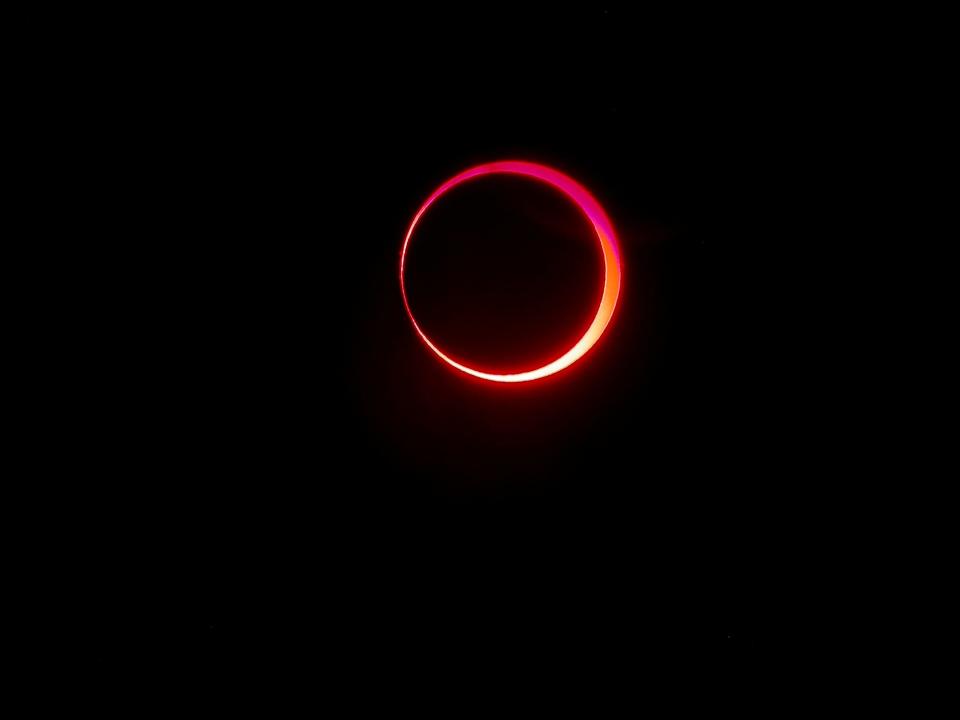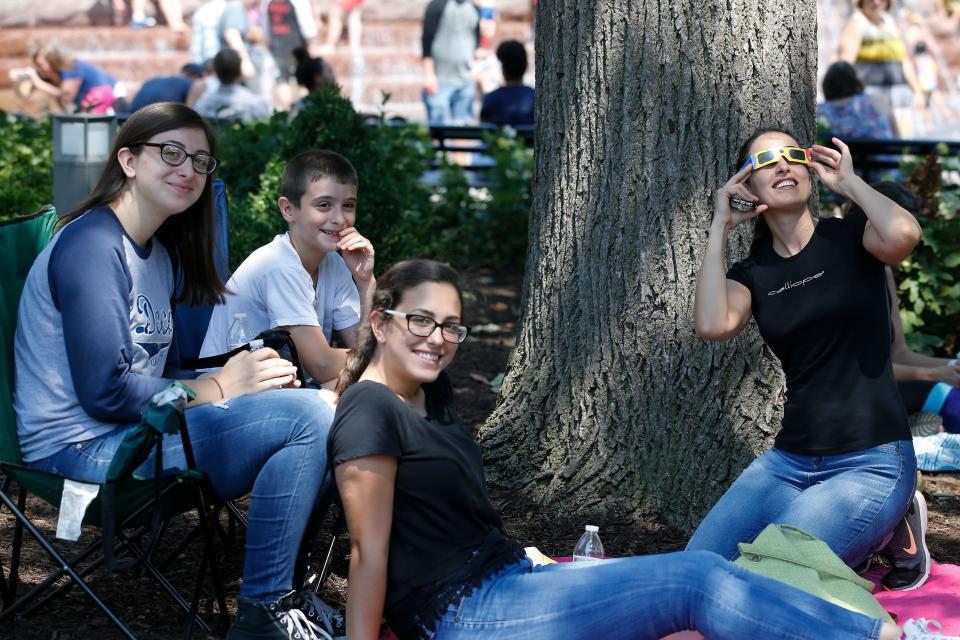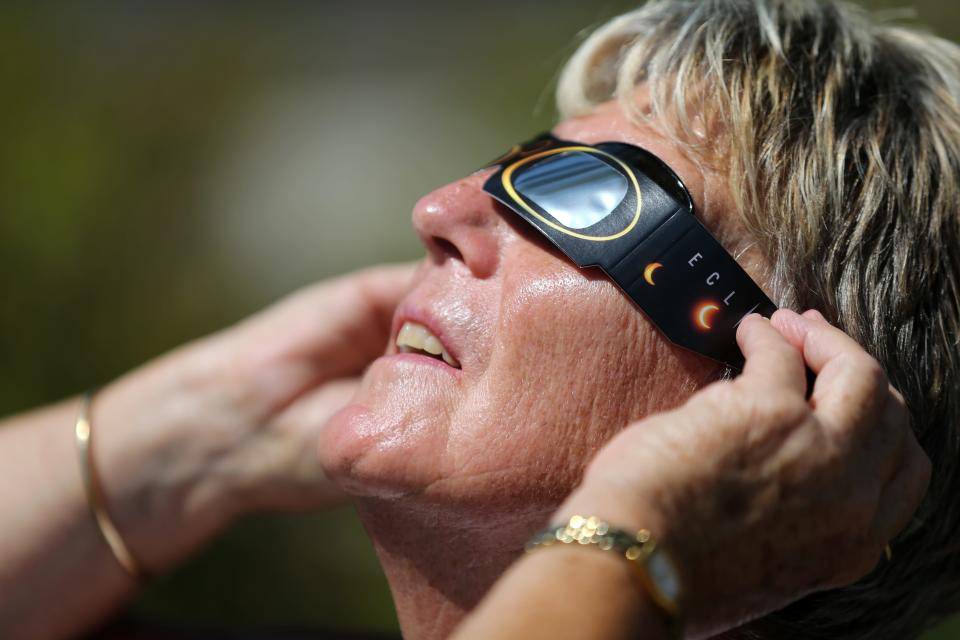Eclipse on Oct. 14 is a dress rehearsal for 'the big one' coming in 2024
Astronomers, backyard stargazers and pretty much anyone interested in space are gearing up for the greatest astronomical show in the universe: a total solar eclipse coming on April 8, 2024. That is the ultra-rare event when the moon completely blocks out the sun and day turns into night for a brief few moments.
But flying under the radar is another very cool eclipse coming this month. On Saturday, Oct. 14, a partial solar eclipse will be visible over almost the entire United States. A narrow swath of the country will be covered by a unique lunar shadow and experience an annular solar eclipse. There, it will look like a ring of fire in the sky for a few minutes.
Solar eclipse types
A solar eclipse happens when the moon passes between the Earth and the sun. If the moon covers part of the sun, it's called a partial solar eclipse – that is what will happen on Oct. 14, 2023.
But when the moon blocks the entire sun (the coolest astronomical event you will ever see) that is a total solar eclipse – and that is coming April 8, 2024.
However, this astronomical event on Oct. 14 is also considered an annular solar eclipse. This occurs when the sun and moon line up but the moon is too far from the Earth to block out the entire sun. The moon will appear smaller than the sun and for some skywatchers in parts of Oregon, Nevada, Utah, Arizona, New Mexico and Texas, the moon will sit inside the solar disc forming an ethereal halo of light.

Viewing an eclipse safely
It is never safe to stare at the sun without proper protection even during solar eclipses. If even 1% of the sun is unblocked by the moon, that light could damage your eyes.
For direct viewing, you must use specially approved eclipse glasses. And if you want to view through a telescope, make sure to place certified safe solar filters in front of the telescope to reduce the light before it enters the telescope.
You can use a hole in a piece of paper to create a pinhole projector. Throughout the solar eclipse, let sunlight shine through the hole and onto the ground. What will show is a copy of the eclipse happening above. The little rays of light will take on the shape of the eclipsed sun displaying an ever-increasing bite taken out of the solar disc by the moon. Many people noticed this effect during the 2017 solar eclipse as each ray of sunlight falling through the leaves cast hundreds and thousands of individual solar eclipse projections on the ground.
Practice for the big one
The Oct. 14 eclipse can be a dress rehearsal for the bigger space show on April 8, 2024. Take the time to test all your safe solar viewing equipment now. Connect with your local astronomy club, science center or observatory. Chances are they will be holding a public event and let you view the eclipse with them and learn more tips and techniques.
You can also take pictures of the eclipse on Oct. 14 with minimal equipment. Although it is not recommended to point your phone directly at the sun for any length of time, you can place a solar filter (either eclipse glasses or a certified solar filter) in front of your camera lens to capture images of the solar eclipse. Placing your camera on a tripod and using the remote shutter can also make your images clearer and allow you to zoom in.
There are a variety of camera adapters that can affix your phone or camera to a filtered telescope. The most dramatic images of the sun usually come through Hydrogen-alpha telescopes. These specially designed telescopes allow you to see solar eruptions called prominences, looping filaments of plasma shooting off the surface of the sun, and add extra flare to eclipse images.

Eclipse timing Oct. 14
The timing for the solar eclipse on Oct. 14 will vary depending on your location. For the Cincinnati area, this is the timeline.
11:42 a.m. Partial eclipse begins.
1:05 p.m. Max eclipse (sun 53% eclipsed).
2:32 p.m. Partial eclipse ends.
For what you will see in your town and when to look, go to timeanddate.com/eclipse and enter your location.

Best places to see 'ring of fire' annularity
If you want to be in the right place at the right time to see the annular solar eclipse on Oct. 14, you need to be under its narrow shadow. The swath of annularity is between 100 and 140 miles wide stretching between the Oregon coast and southern Texas. Annularity will be visible from cities such as Elko, Nevada; Albuquerque, New Mexico; and San Antonio, Texas. Or you could view it from one of the National Parks such as Crater Lake, Oregon; Great Basin, Nevada; and Capitol Reef, Utah.
For more details and maps go to greatamericaneclipse.com
Dean Regas is an astronomy educator and author of six books including "1000 Facts About Space" and "How to Teach Grown-Ups About Pluto." He hopes to see the eclipse from Roswell, New Mexico, on Oct. 14 and can be reached at www.astrodean.com.
This article originally appeared on Cincinnati Enquirer: Oct. 14 eclipse is rehearsal for big one coming April 8, 2024

